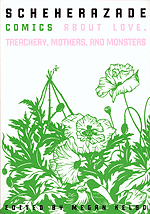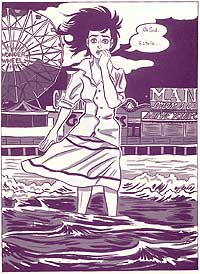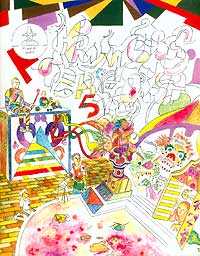
|
"Scheherazade: Comics about love, treachery, mothers, and monsters" (Soft Skull Press; $20; 223 pages), edited by Megan Kelso, has been organized on a principle that is both fundamental and elusive: all the contributors are women. Unlike the more radical "We exist!" statements of past women cartoonist collections, Kelso uses the book to explore the more subtle theme of the way women treat the narrative form differently than men. She tantalizingly stops short of saying how they may differ, so part of the book's pleasure comes from thinking about this idea. A superficial flip-though won't provide an answer. The 23 contributions cross boundaries of tone, subject and style. Leela Corman's emotionally raw tenement story of a young girl facing the mysteries of womanhood looks almost like a child's therapy comic. Eleanor Davis' "The Bird Eater," rendered in a style reminiscent of Aesop's fable woodcuts, tells a strange parable of a monster that terrorizes a community of tree-dwelling gnomes. Non-fiction also appears in the form of Gabriella's Gamboa's curious history of the Fox sisters, a trio of phony spiritualists from the 19th century. No two contributors have the same approach. So, is the notion of a "woman's" voice apocryphal?
 ROUGH SEAS: Ellen Lindner's "Undertow" in "Scheherazade"
ROUGH SEAS: Ellen Lindner's "Undertow" in "Scheherazade" |
Not quite. One clear thread emerges: the need to tell stories about women. Nearly all the contributions focus on female characters. This alone makes the book a pleasure for both genders. Women will likely see parts of their own lives appear with a refreshing authenticity while men can enjoy a trip through the looking glass. Allison Cole, for example, turns in "Joe Blow," a creepy slice of life story about a perv who stalks a pair of roommates. Nearly every woman has some kind of scary harassment story but seeing one in comix form still comes as a shock. Another commonality in "Scheherazade" is a greater interest in exploring the nuances of relationships. Ellen Lindner's "Undertow," with the look and feel of a comix "Mildred Pierce," paints a noirish portrait of two girlfriends in the 1950s. The book's strongest piece, Gabrielle Bell's "One Afternoon," combines the yin/yang of a relationship study with a compact, twisty plot. Drawn with a simple clarity, it brilliantly updates one of Kate Chopin's devastating portraits of a caustic marriage hidden behind a veneer of politeness and misguided obligation.
Readers should be warned, however, that the initial print run suffers from a shockingly sub-par print job. Printed with purple ink on off-white paper, artists who use softer mediums like pencil have had their details either not come through or else had their subtle shades turned into uniform, mushy blobs. The publisher assures me that a second, superior print will arrive in January but copies of the first have already arrived in chain stores (including Amazon) and will not be replaced. You are advised to wait a while before seeking the book out and to avoid getting it online. Check the indicia for the edition or just give the book a flip-through. This initial snafu shouldn't deter you. "Scheherazade" has much to recommend it both in its variety of artistic styles and the quality of the work. The fact that it features women artists becomes just another facet to this gem of a book.

|
"Kramer's Ergot" #5 (Gingko Press; 320 pages), edited by Sammy Harkham, also has a jewel-like quality. It's so aesthetically pure that it doesn't even print a price on the book. (It's $30). Appearing only annually, last year's giant issue established the series as the premier showcase for emerging/edgy talent by insisting on the seriousness of their endeavors with its sumptuous production values. (See TIME.comix review.) Printed in full color on thick paper stock at a large size, "Kramer's Ergot" allows artists who would otherwise only know inexpensive reproduction to see their work monumentalized. This latest issue goes one better than the last by including both lesser known artists and also relative veterans whose work fits the avant-garde mold of the series. As a result "Kramer's Ergot" #5 stands out as not just one of the year's best anthologies, but also one of the year's most gorgeous books.
From the establishment, Chris Ware provides another brief chapter in his sporadically printed series about a lonely young woman living in an apartment building. One remarkable page encapsulates the lives of the building's residents, along with a bee, through schematically arranged, interconnecting panels. The book also features "Drill Core Sample," by Gary Panter, the cartoonist's cartoonist since the 1980s. Comprised of one page from a sketchbook done in each of the last 30 years, it offers a fascinating slice of his evolving interest in the constructs of "cartoons." Of the work by relative newcomers, "My Sexual History (Slightly Abridged Version)," by David Heatley (who also appears in "McSweeny's" #13), stands out as another in the brutal honesty school of autobio comix. Rendered as 672 tiny panels across fifteen pages, the title delivers on its promise of full exposure, tracing the author's sexual maturation with explicit candor. Like it or not you can't turn away.
Though it has no stated theme, a number of the contributions to "Kramer's Ergot" #5 share a curious interest in the nature of religion and faith. Kevin Huizenga, a major emerging talent whose first solo book, "Or Else," has just been published by Drawn and Quarterly, contributes the best of the more traditional narrative offerings. "Jeepers Jacobs," beautifully rendered in the pastels of dappled summer sunlight, effortlessly mixes the comedy of human foibles with the debate over the existence of hell. Among other things, its thoughtful portrait of a religious conservative ingeniously rebuts the divisive and absurd language of red vs. blue.
 ROUGH EDGES: a page from C.F.'s "Castor and Pollux" in "Kramer's Ergot" #5
ROUGH EDGES: a page from C.F.'s "Castor and Pollux" in "Kramer's Ergot" #5 |
In spite of "Kramer's" monumentalizing, none of the contributors seem outclassed. The deluxe treatment brings out a level of artistry in even the simplest style. The ones who specialize in complex detail are put to special advantage. Marc Bell, for example, creates fantastical, hilarious universes filled with characters doing something in every corner. Besides a fearlessness of "blowing up" edgy creators, Harkham's boldness also shows itself in a willingness to expose the materials of comix. The typically taboo corners, edges and surfaces of the original artwork have been made fully visible in some cases. "Castor and Pollux," a poetic single page by an artist known as "C.F." appears on a piece of torn-out spiral notepaper, complete with the rough fringe on the left edge. Souther Salazar's "Fervler 'n Razzle," features the antics of a pair of doodles on whatever surface the artist seems to have around. One strip puts them on a drinking straw wrapper. Reproducing these works as-is makes them seem almost sculptural, adding a thrilling third dimension to the traditionally flat comix surface.
In a year of excellent anthologies both "Kramer's Ergot" and "Scheherazade" stand out as exceptional. Anthologies live or die by their editor's hand. "Kramer's Ergot" #5 and "Scheherazade" both provide smartly guided rides through some of comix' unexplored and gorgeous hinterlands.
